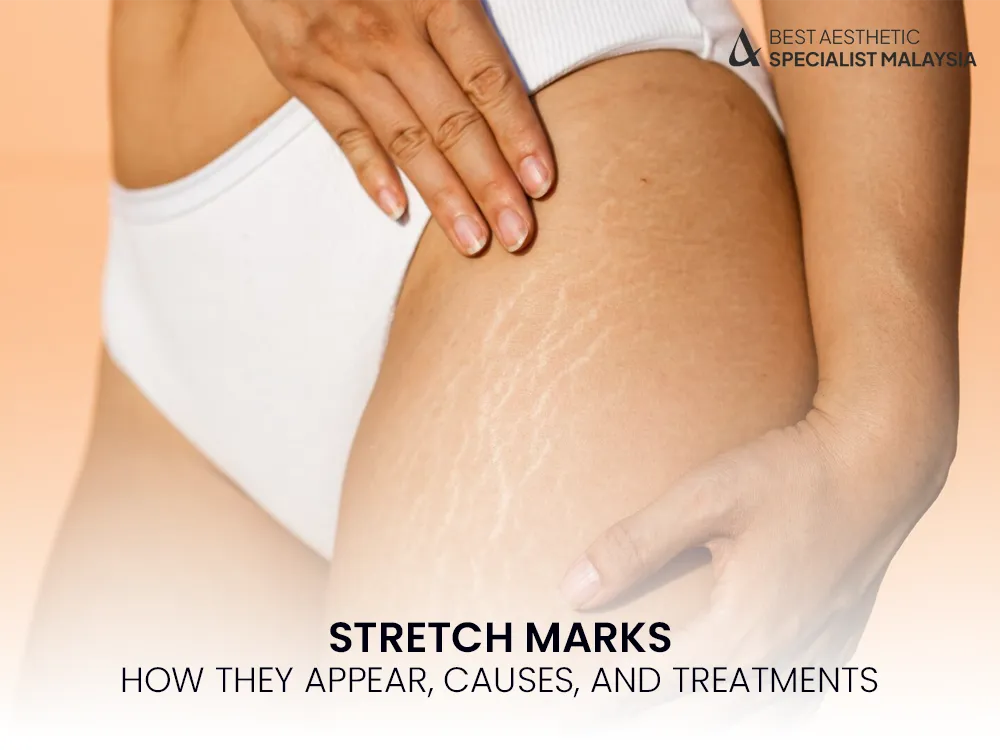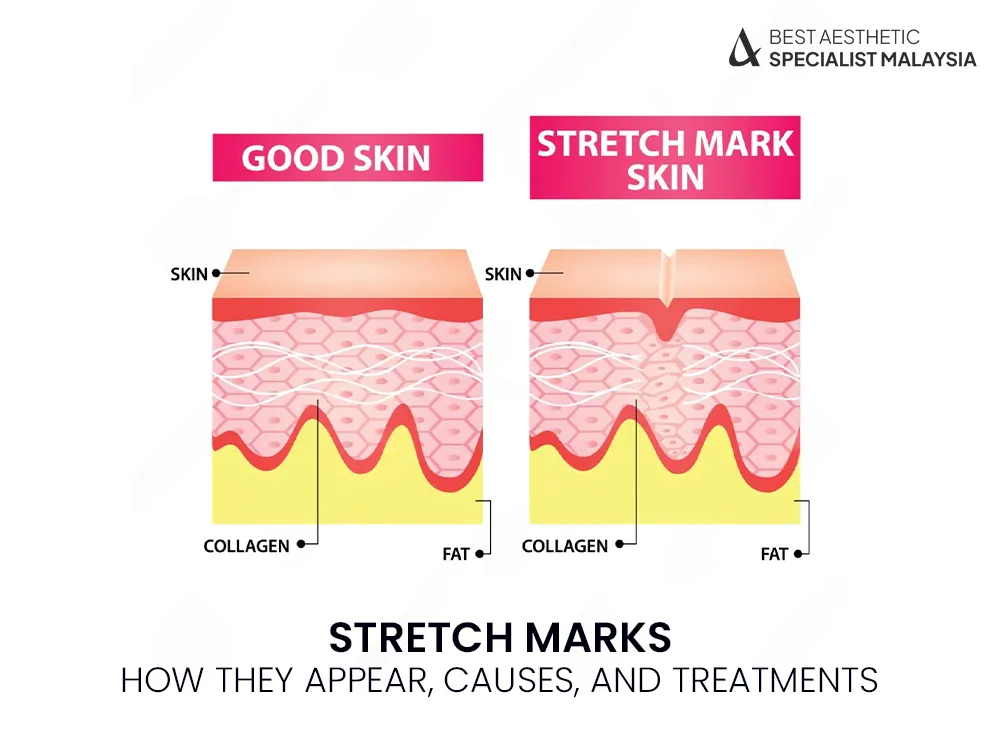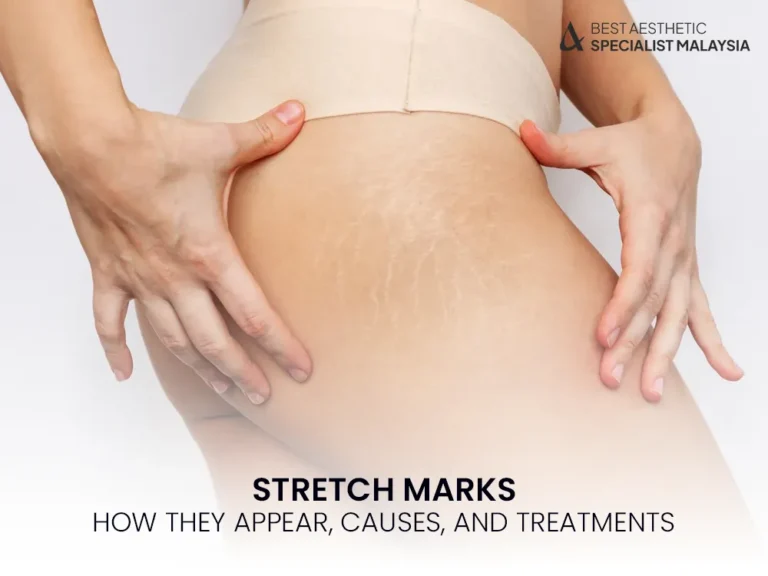Stretch Marks
Stretch marks, also known as striae, are a common skin concern affecting people of all ages, genders, and skin types. While they are not harmful, many individuals seek ways to prevent or treat them for aesthetic reasons. This blog delves into what stretch marks are, how they form, their causes, and the most effective treatments to minimize their appearance.
What Are Stretch Marks?

Stretch marks are long, narrow streaks or lines that develop on the skin when it stretches or shrinks rapidly. This sudden change causes the collagen and elastin in the skin to rupture. As the skin heals, stretch marks may form as scars.
Initially, stretch marks appear as red, purple, or brown streaks (depending on your skin tone). Over time, they often fade to a lighter shade, becoming less noticeable but rarely disappearing completely.
Stretch marks are most commonly found on the abdomen, thighs, hips, breasts, and lower back.
How Do Stretch Marks Appear?

Stretch marks form in the middle layer of the skin, called the dermis, when it is overstretched. This happens when the skin’s elastic fibers are pulled beyond their capacity, leading to small tears. The body repairs these tears with scar tissue, resulting in stretch marks.
There are two main phases of stretch marks:
- Early Stage (Striae Rubrae): Stretch marks appear red, purple, or pink and may feel slightly raised or itchy. This is the best time to treat them, as they are more responsive to intervention.
- Later Stage (Striae Albae): Over time, stretch marks fade to a white or silver color and become flatter. They are more challenging to treat at this stage.
Causes of Stretch Marks
Stretch marks occur due to a combination of factors, including skin stretching, hormonal changes, and genetic predisposition. Below are the most common causes:
1. Rapid Weight Changes
Sudden weight gain or loss can cause the skin to stretch or shrink quickly, leading to the development of stretch marks.
2. Pregnancy
Stretch marks are common during pregnancy, especially in the third trimester, as the skin stretches to accommodate the growing baby. Hormonal changes during pregnancy also play a role.
3. Puberty
During puberty, rapid growth spurts and hormonal fluctuations can lead to stretch marks on the thighs, hips, and breasts.
4. Genetics
If your parents or close relatives have stretch marks, you are more likely to develop them. Skin elasticity is often hereditary.
5. Corticosteroid Use
Prolonged use of corticosteroid creams or medications can reduce collagen levels in the skin, increasing the risk of stretch marks.
6. Medical Conditions
Certain medical conditions, such as Cushing’s syndrome or Marfan syndrome, can weaken the skin’s elasticity, making stretch marks more likely.
Treatments for Stretch Marks
While stretch marks are permanent, various treatments can help reduce their appearance. The effectiveness of treatment depends on the age and severity of the stretch marks. Below are some of the most popular stretch marks treatment options:
1. Topical Creams and Lotions
- Products containing retinoids (like tretinoin) can improve the appearance of early-stage stretch marks by stimulating collagen production.
- Hyaluronic acid and vitamin E-based creams help keep the skin hydrated and improve elasticity.
Note: Retinoids should not be used during pregnancy.
2. Microdermabrasion
This non-invasive procedure uses fine crystals to exfoliate the top layer of skin, promoting cell turnover and reducing the appearance of stretch marks.
3. Chemical Peels
Chemical peels involve applying an acid solution to the skin to remove the outer layer and stimulate collagen production. These treatments are effective for improving skin texture and minimizing stretch marks.
4. Laser Therapy
Laser treatments, such as fractional CO2 lasers or pulsed dye lasers, are highly effective in reducing the color and texture of stretch marks. Lasers work by stimulating collagen and elastin production in the skin.
5. Microneedling
Microneedling involves creating tiny punctures in the skin with fine needles to stimulate the body’s natural healing process. This boosts collagen production, improving the appearance of stretch marks.
6. Platelet-Rich Plasma (PRP) Therapy
PRP therapy uses the patient’s blood plasma, which is rich in growth factors, to stimulate skin repair and collagen production. When combined with microneedling, it can deliver impressive results.
7. Radiofrequency Treatments
Radiofrequency devices deliver heat to the skin’s deeper layers, tightening the skin and improving elasticity. This treatment is effective for older, more stubborn stretch marks.
Prevention of Stretch Marks
While it’s impossible to completely prevent stretch marks, certain steps can reduce your risk:
- Moisturize Regularly: Keeping the skin hydrated with creams or oils can improve elasticity and reduce the likelihood of stretch marks forming.
- Maintain a Healthy Weight: Avoid rapid weight changes by following a balanced diet and exercise routine.
- Use Topical Treatments Early: Products containing hyaluronic acid, cocoa butter, or shea butter can help keep the skin supple during periods of rapid growth, like pregnancy or puberty.
- Stay Hydrated: Drink plenty of water to maintain skin elasticity.
- Take Care During Pregnancy: Pregnant women can use pregnancy-safe creams and oils to nourish the skin and minimize stretching.
5 FAQs About Stretch Marks
1. Can stretch marks disappear completely?
Stretch marks rarely disappear completely, but they can fade and become less noticeable over time. Treatments like laser therapy and microneedling can significantly reduce their appearance.
2. Are stretch marks a sign of a medical condition?
In most cases, stretch marks are caused by normal life events like pregnancy or puberty. However, if they appear suddenly without an obvious cause, they may indicate a medical condition like Cushing’s syndrome or Marfan syndrome.
3. Do over-the-counter creams really work for stretch marks?
While no cream can completely remove stretch marks, some products can improve skin elasticity and reduce their visibility. Look for ingredients like retinoids, hyaluronic acid, and vitamin E.
4. Is laser therapy safe for all skin types?
Yes, laser therapy is generally safe for all skin types. However, certain lasers are more suitable for darker skin tones. It’s important to consult a qualified dermatologist for the best results.
5. When is the best time to treat stretch marks?
Early treatment is key. Stretch marks in their red or purple stage (striae rubrae) respond better to treatments like topical creams and lasers than older, white stretch marks (striae albae).
Conclusion
Stretch marks are a natural and common skin concern that many people experience at some point in their lives. While they cannot be completely prevented or erased, there are numerous treatments available to minimize their appearance and improve skin texture. Whether you choose topical creams, laser therapy, or microneedling, early intervention can lead to better results.
If you’re considering treatment for your stretch marks, consult with a dermatologist to determine the best option for your skin type and condition. With the right care and approach, you can achieve smoother, more confident skin!

